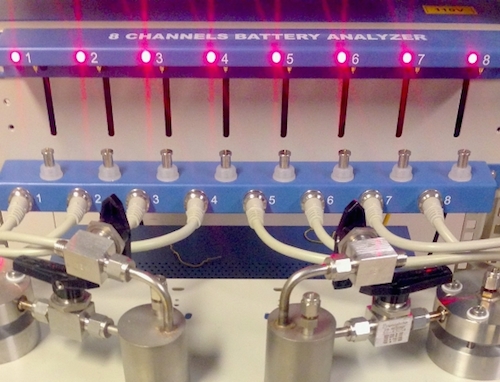World’s First “Breathing” Solar Battery
A research team at The Ohio State University is laying claim to the world’s first “breathing” solar battery that recharges itself with air and light. If you’re familiar with air batteries you already have the first part down, but the solar battery aspect is the killer app in terms of overall costs. By combining a solar cell and battery in one nifty package, the team anticipates a potential savings of 25 percent.
Weren’t we just saying that the cost of portable solar devices is high now but will quickly drop as new technologies come on board?

Cost Of Solar Chargers Set Up For A Fall
Actually, we said nothing of the kind, but we were thinking about it. Over the past few months we’ve reviewed a few portable solar chargers (also here and here), and some commenters have blown them off as expensive toys.
That pretty much nails the state of play now, but those of you who are old enough to have experienced high school in the 1970’s may recall that when pocket calculators were first introduced, only the rich kidz had them. Also, all they could do was calculate.
Fast forward to this generation, and now an even smaller device — your cell phone — can do all of those functions along with however many apps you download to say nothing of the camera and the phone. That can still be a pricey package but if all you want is a pocket calculator, those are practically free.
We’re also thinking that the technology will bump up as portable solar car chargers and other more powerful, transportable solar systems enter the marketplace.
Drop a note in the comment thread if you have some thoughts about the e-waste issues raised by portable solar chargers, but after hearing about this new air battery/solar combo we’re even more convinced that portable solar chargers will follow a similar path to affordability and versatility.
We Built The World’s First Solar Battery!
Where were we? Oh right, the world’s first solar battery.
The OSU team has already spun off a company called KAir Energy Systems LLC (not to be confused with another company called K°Air Energy, Inc.) that developed a potassium-air battery, which will form the heart of the solar battery. It was leveraged with the help of a $100,000 Department of Energy prize garnered at a clean energy business plan competition earlier this year, so group hug all you taxpayers out there.
The Energy Department is also funding the study that will lead to a solar battery version, so extra special hugs.
The Energy Department sums up the elevator pitch for the battery:
KAir Battery develops clean, energy efficient, and cost-effective large-scale stationary potassium-air (K−O2) batteries. These batteries could support renewable energy systems by storing excess power and distributing it at times of peak consumer demand. According to KAir, these batteries store generated electricity and return 98% of the input energy.
Once you’ve got this great battery based on non-toxic materials (who could hate potassium?), why not gild the lily by generating the electricity with solar energy?
The sticky wicket is the air part of the equation. Conventional solar panels would stop air from getting into the battery, so the solution was to design a mesh-style panel.
Made of titanium gauze, the mesh sports perpendicular nanoscale rods of titanium dioxide. The rods capture solar energy while the mesh structure enables air to flow freely.
If the nanorod structure is ringing some bells, you may be thinking of the gold nanorod solar cell under development at UC – Santa Barbara, which also sport titanium and platinum crystals at their tips.
Another familiar-sounding aspect of the mesh is the use of rust as a semiconductor for solar cells. That angle is also being pursued by a team from France and Israel, for using solar energy to generate hydrogen fuel from water.
Getting back to the solar battery, here’s where it gets interesting. A conventional solar cell uses four electrodes, but in the new solar battery, the titanium mesh itself counts as an electrode. Here’s a rundown on the other three from OSU:
Beneath, the researchers placed a thin sheet of porous carbon (the second electrode) and a lithium plate (the third electrode). Between the electrodes, they sandwiched layers of electrolyte to carry electrons back and forth.
The three-legged electrode structure results in the transfer of virtually all of the electrons from the solar cell to the battery, compared to 80 percent for conventional systems consisting of separate solar cells and batteries.
When the sun is out, the mesh generates electrons that interact with lithium peroxide from the plate, resulting in lithium ions and oxygen.
The oxygen discharges, while the lithium ions remain in the battery in the form of lithium metal.
When the battery is in use, it takes in ambient oxygen to recreate the lithium peroxide.
One key improvement cited by OSU is a “shuttle” mechanism consisting of an iodide additive, which creates a smoother path for electrons as they move between the battery and the solar panel.
As for the cost of solar energy, the press materials were a little vague but the team seems confident that the solar battery will provide a 25 percent savings in costs, presumably compared to the cost of separate solar panels and batteries.
The KAir battery itself is ready for its closeup in terms of licensing to industry. As for the solar battery version, that’s still in the study phase so stay tuned.
Follow me on Twitter and Google+.
Have a tip for CleanTechnica? Want to advertise? Want to suggest a guest for our CleanTech Talk podcast? Contact us here.
Latest CleanTechnica.TV Video

CleanTechnica uses affiliate links. See our policy here.

